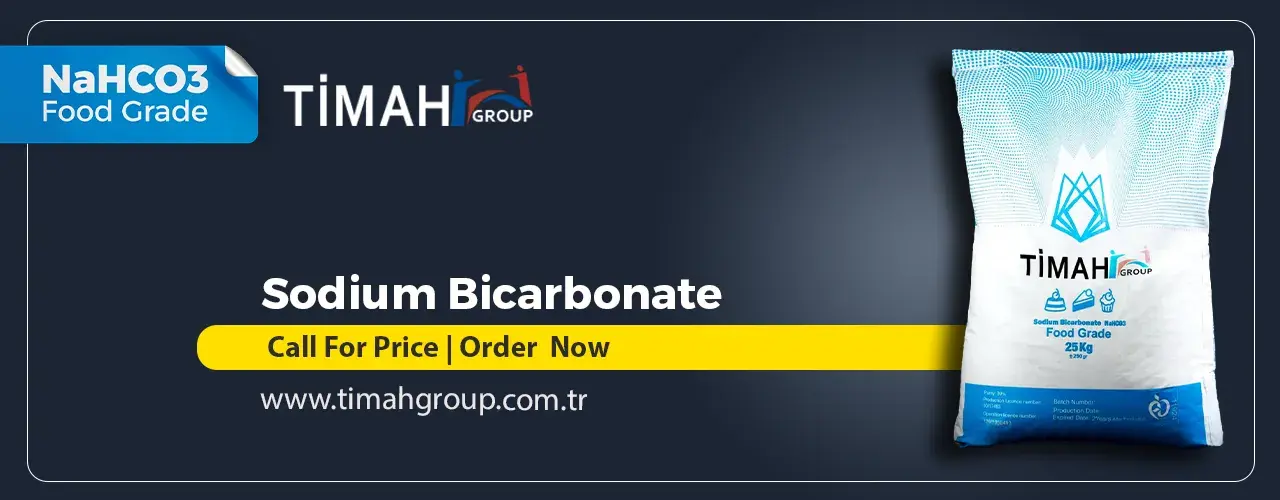What is Sodium Bicarbonate?
Sodium bicarbonate, chemical formula NaHCO3, commonly known as baking soda, is a white, crystalline powder with a slightly salty taste. It's composed of sodium ions (Na+) and bicarbonate ions (HCO3-). Sodium bicarbonate has various uses, including as a leavening agent in baking, a cleaning agent, an antacid for indigestion relief, and in certain medical treatments.
Technical Specifications:
- Chemical name: sodium bicarbonate
- Chemical formula: NaHCo3
- Melting point: Decomposes at temperatures above 50 degrees Celsius.
- Solubility in water: 8.7 g/100 ml of water (at 20°C).
- Appearance: white powder
- Grade: food, livestock and poultry, industrial
Applications of sodium bicarbonate
Sodium bicarbonate, commonly known as baking soda, has numerous uses in various fields.
What is Sodium Bicarbonate used for?
-
Cooking: Sodium bicarbonate is used as a leavening agent in baking. When it reacts with acidic ingredients like vinegar, lemon juice, or buttermilk, it produces carbon dioxide gas, which helps dough or batter rise and become light and fluffy.
-
Cleaning: It's an effective and natural cleaning agent due to its abrasive properties and ability to dissolve grease and dirt. It's commonly used for scrubbing surfaces, deodorizing, and removing stains.
-
Antacid: Sodium bicarbonate can be used to relieve heartburn and indigestion by neutralizing excess stomach acid. It's often taken as a remedy by dissolving it in water and drinking it.
-
Personal Care: Sodium bicarbonate is sometimes used in toothpaste and mouthwash for its mild abrasive properties, which help to remove plaque and stains from teeth. It's also used in some bath products for its skin-soothing properties.
-
Fire Extinguisher: Sodium bicarbonate can be used in some types of fire extinguishers. When it's heated, it releases carbon dioxide, which helps smother the flames by displacing oxygen.
-
Deodorizing: It's commonly used to neutralize odors in refrigerators, shoes, carpets, and other household items.
-
Medical Uses: Sodium bicarbonate is sometimes used in medical settings to treat certain conditions such as metabolic acidosis or to correct the pH of blood in cases of acidosis.
Overall, sodium bicarbonate is a versatile compound with numerous practical applications in various aspects of daily life.
Sodium Bicarbonate Formula
The chemical formula for sodium bicarbonate, commonly known as baking soda, is NaHCO3. It consists of one sodium (Na) atom, one hydrogen (H) atom, one carbon (C) atom, and three oxygen (O) atoms.
Sodium Bicarbonate for Pools
Sodium bicarbonate can be used in pools to raise the alkalinity of the water. Alkalinity is a measure of the water's ability to resist changes in pH, and maintaining the proper alkalinity level is crucial for balanced pool water. Sodium bicarbonate acts as a buffer, helping to stabilize the pH level of the pool water and prevent fluctuations that can lead to corrosion of equipment and discomfort for swimmers.
When using sodium bicarbonate in pools, it's essential to follow proper dosage guidelines based on the pool's size and current alkalinity levels. Overdosing can lead to excessively high alkalinity levels, which may cause cloudiness in the water and make it difficult to maintain proper pH balance.
Additionally, sodium bicarbonate should be distributed evenly throughout the pool to ensure thorough mixing and effectiveness. It's also essential to regularly test the pool water's alkalinity and pH levels and adjust the sodium bicarbonate dosage as needed to maintain optimal water balance.
Overall, sodium bicarbonate can be a useful tool for pool maintenance, helping to keep the water balanced and comfortable for swimmers. However, it's essential to use it properly and monitor water chemistry regularly to ensure a safe and enjoyable swimming environment.
Sodium Bicarbonate Boiling Point
The boiling point of sodium bicarbonate, also known as baking soda, is approximately 851 degrees Celsius (1564 degrees Fahrenheit). At this temperature, sodium bicarbonate undergoes thermal decomposition, breaking down into sodium carbonate, water vapor, and carbon dioxide gas.
Sodium Bicarbonate ph
Sodium bicarbonate, commonly known as baking soda, has a pH level of around 8.3 when dissolved in water. This makes it slightly alkaline. However, its pH can vary depending on factors such as concentration and temperature. In solutions, sodium bicarbonate acts as a buffer, helping to resist changes in pH.
Sodium Bicarbonate side effects
Sodium bicarbonate, when used in appropriate amounts and for intended purposes, is generally safe for consumption and other applications. However, excessive or improper use may lead to side effects, especially when ingested. Some potential side effects of sodium bicarbonate include:
- Gastric Distress: Taking too much sodium bicarbonate orally can cause gastric distress, including bloating, gas, and abdominal pain. This is particularly true if taken on an empty stomach.
- Alkalosis Sodium bicarbonate can increase the pH of the blood if taken in large amounts or for an extended period. This can lead to a condition called metabolic alkalosis, characterized by symptoms such as confusion, muscle twitching, and irregular heartbeat.
- Electrolyte Imbalance: In some cases, excessive sodium bicarbonate intake can disrupt the balance of electrolytes in the body, leading to conditions like hypernatremia (high sodium levels) or hypokalemia (low potassium levels).
- Kidney Stones:Long-term use of sodium bicarbonate as an antacid may increase the risk of developing kidney stones in susceptible individuals, especially those prone to calcium-containing stones.
- Drug Interactions:Sodium bicarbonate may interact with certain medications, such as aspirin, corticosteroids, and medications containing sodium, leading to reduced effectiveness or increased side effects.
- Allergic Reactions:While rare, some individuals may experience allergic reactions to sodium bicarbonate, resulting in symptoms such as rash, itching, swelling, or difficulty breathing.
